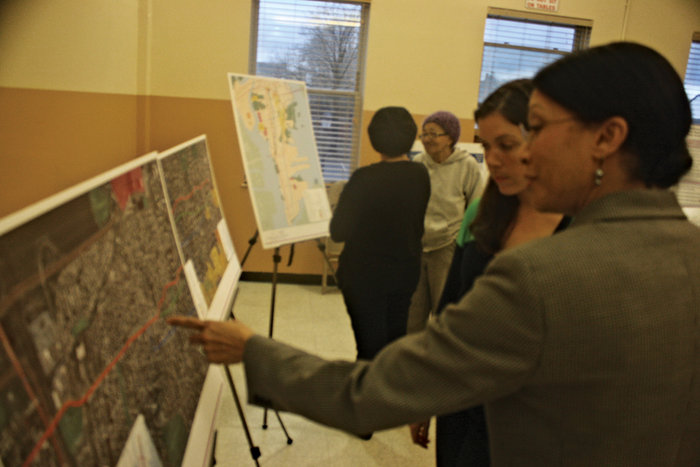A study that seeks to improve north-south routes between Bayonne and Journal Square that improvements to bus services along Kennedy Boulevard, Bergen Avenue and MLK Drive would provide more rapid service to riders.
Kennedy Boulevard scored highest in the study as the best location in the study area for the possible inclusion of rapid bus system in Bayonne and in Jersey City, followed by a combination of Kennedy and Bergen Avenue, and thirdly, MLK Drive.
The study that began last year was a joint venture between the North Jersey Transportation Planning Authority, the Hudson County Planning Department, the city of Jersey City and the City of Bayonne to determine how to improve service along a very congested area of Hudson County.
While the study isn’t binding, the group unveiled its findings at a public hearing of possible Bus Rapid Transit route at the Mary McLeod Bethune Life Center on March 12.
Peter Brennan and a handful of residents came to hear a short presentation and to get a better understanding of what the study showed.
“If this study shows that there is a market for the BRT, then it can happen fairly quickly.” – Joseph Barr
____________
She said she had come to the hearing to see what improvements could be made to help enhance the bus service.
Megan Massey, of the Hudson County Division of Planning, said the study was looking for ways to improve service not just from Bayonne to Journal Square, but as the first leg also to areas beyond, since many people are going to other places such as Exchange Place in Jersey City or to New York City.
The study — which started last year — set a number of goals such as matching the proposed improvements to the needs of the area, how to keep costs manageable, what long term and short term improvements can be implemented, and how to link this system up with systems that reach other areas beyond the study area
The study area covers most of the north south routes from Bayonne to Journal Square including Route 440, Kennedy Boulevard, Avenue C in Bayonne, Bergen Avenue in Jersey City, West Side Avenue in Jersey City, MLK Drive in Jersey City and Ocean Avenue in Jersey City.
“We’re looking at what the need is for BRT and what the opportunities are,” said Joseph Barr, spokesperson for the study group.
BRT is a flexible, high performance system of buses that increase the speed, reliability and customer convenience within a transportation corridor. Systems vary depending on the area and in the region; New York City and Newark have implemented some version of this system
Although the system can resemble light rail in some cases, Barr said the advantage of the BLT is extremely flexible, and can be implemented much more quickly than a light rail system.
“If this study shows that there is a market for the BRT, then it can happen fairly quickly,” he said.
“The goal of this is to move people through the study area, but also move them up to Journal Square then to other places such as Exchange Place,” Barr said.
He said the majority of people who travel outside the study area are going to Manhattan.
The idea of BRT is to appeal to people who currently do not use bus service now as well as to improve the experience for people who current take buses.
The system could included dedicated bus lanes – which could be lanes that already exist or to completely separated lane like a train line.
The system could provide signal priority allowing buses to communicate with traffic signals. This could stop the light from turning red as the bus approaches the intersection. Enhanced stations could include upgrades such a better lighting or seating areas and in some cases, the sidewalk connection is elevated up to the level of the bus’s first step. The program could also improve fare collection – different ways to pay so that people aren’t lining up to wait to board. This could be something similar as pre pay stations like those currently found at light rail stations where employees later check for tickets after people have boarded; or the use of smart cards that allow people to access more than one door of the bus at a time.
An enhanced service plan would include more direct routes and fewer stops and newer and improved vehicles.
Two corridors were looked at in Bayonne: Avenue C and Kennedy Boulevard, both more or less starting at the 8th Street station of the Hudson Bergen Light Rail Line, although Barr said. This could be adjusted to go farther south if a BRT was needed.
Kennedy Boulevard is the only street in the study area that runs the length of Bayonne and beyond Journal Square in the north.
Although the study isolated the corridors in Jersey City and Bayonne, Barr said there were opportunities to make a hybrid corridor that included elements of more than one of these corridors.
In evaluating each, the study looked at existing bus service and its ridership, the number of connecting transit services, the distance from Bayonne to Journal Square, existing sidewalks, cross walks, and adjacent street traffic speeds, schools, universities, shopping areas and other community facilities, space for other vehicles to pass halted buses, space for creating exclusive right of way for buses and other criteria.
Al Sullivan may be reached at asullivan@hudsonreporter.com.
